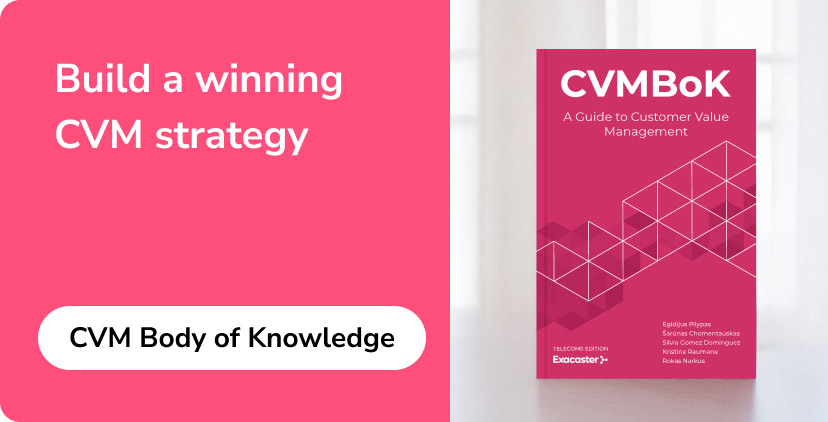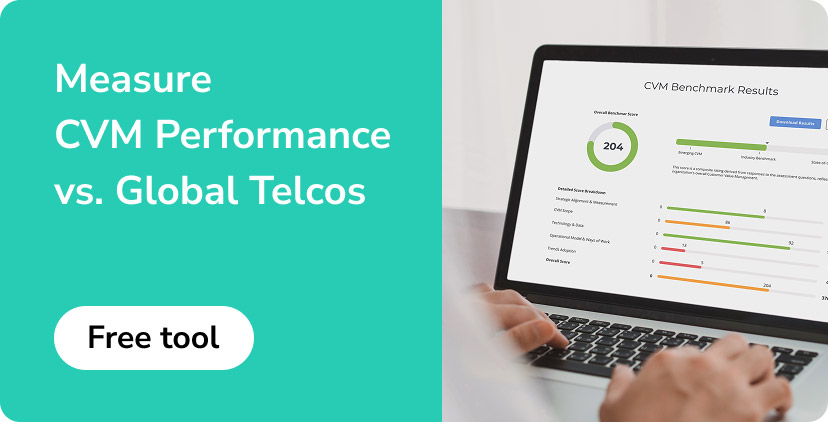Introducing The Strategic CVM Alignment Tool
Senior executives use the Strategic CVM Alignment Tool for strategic marketing decisions. It comprises a set of 20 difficult-to-answer questions that require discussion and written answers in order to create a shared understanding between senior leadership and team leaders driving CVM on daily basis. Assuming the business has at least an informally aligned and mostly coherent strategy the tool can be fully utilized in about 4 weeks with 1-2 workshops per week plus several days of work every week to fill in the gaps between the sessions.
|
STRATEGIC CVM ALIGNMENT TOOL |
Customer perspective |
|||
|---|---|---|---|---|
|
A. PERSONA |
B. NEEDS (Jobs-to-be-done) |
C. ALTERNATIVES |
||
|
Business perspective |
D. STRATEGY |
1: Which market are we playing in? 2: Which personas are there in the market? 3: Which personas we are targeting/should target? 4: What P.E.S.T.L. trends are there? 5: Which PESTL trends are impacting our organization? |
6: What are the needs/jobs-to-be-done of our targeted personas? 7: Which needs/jobs-to-be-done do we serve/should serve? 8: Which P.E.S.T.L. trends are impacting the needs of our personas? 9: Which services/products/ features can we introduce or change to fulfill the target persona’s needs/jobs-to-be-done? |
10: In What ways can the customer address his job-to-be-done alternatively? 11: Which P.E.S.T.L. trends are impacting the alternatives? 12: What is our value proposition for the customer in light of the alternatives? 13: What is the differentiation of our value proposition in the market vs alternatives? |
|
|
14: What is our SWOT in relation to the target persona, value proposition and differentiation? 15: What are our best bets / fastest ways to provide targeted persona with the differentiated value proposition? |
|||
|
E. BUSINESS OBJECTIVES |
16. What are the long term (5-10 year) objectives for our bets? 17. What are the medium term (3-5 year) goals for our bets? 18. What are the short term (1-2 year) targets to be achieved? |
|||
|
F. MAJOR INITIATIVES & PROGRAMS |
19. What are the major service/product, organizational and technological capabilities necessary? 20. What major activities are needed to create the capabilities? 21. What are the budgets necessary? |
|||
Review each question as follows:
|
STRATEGIC CVM ALIGNMENT TOOL |
Customer perspective |
|
|---|---|---|
|
A. PERSONA |
||
|
Business perspective |
D. STRATEGY |
Which market are we playing in? |
This question is about narrowing down the scope further work. The market may be defined geographically, linguistically, by type of customer, by type of service, etc. Setting clear boundaries improves creativity and productivity of the exercise that follows.
- Assumed answer before discussion: “We are playing in the telecommunications market of country X”.
- Actual answer after discussion: “We are playing in the telecommunications and media market of country X and neighboring countries Y and Z”.
|
STRATEGIC CVM ALIGNMENT TOOL SESSION 2 |
Customer perspective |
|||
|---|---|---|---|---|
|
A. PERSONA |
B. NEEDS (Jobs-to-be-done) |
C. ALTERNATIVES |
||
|
Business perspective |
D. STRATEGY |
Which personas are there in the market? |
What are the needs/jobs-to-be-done of the personas? |
In what ways can the customer address his job-to-be-done alternatively? |
These 3 questions are related, and aim to better understand the market the organization chose to play in, the unique sets of needs and accordingly the set of customer types (“segments” or “personas”) that are there in the market. We recommend to use the Jobs-to-be-done framework [4] for this part of analysis. At the heart of Jobs-to-be-done framework is the customer Persona, characterized by a range of needs (jobs-to-be-done) that can be addressed in multiple ways (Alternatives).
- Persona
Who are the typical customers and what are their distinguishing characteristics? - Jobs to be Done
What are the primary needs and expectations of these personas? - Alternatives
Given the specific job-to-be-done, what alternatives might the persona consider and why?
Please note that Customer segments or personas are defined by virtue of having a unique set of needs and characteristics – so the discovery of needs goes first, and then they are grouped into personas afterwards. However it may be easier to proceed in iterative fashion and revise personas & jobs-to-be-done together.
|
STRATEGIC CVM ALIGNMENT TOOL SESSION 3 |
Customer perspective |
||
|---|---|---|---|
|
A. PERSONA |
B. NEEDS (Jobs-to-be-done) |
||
|
Business perspective |
D. STRATEGY |
Which personas we are targeting/should target? |
Which needs/jobs-to-be-done do we serve/should serve? |
These 2 questions begin to position the business in light of the persona and his needs – the answers to these two questions are usually the outcome of the company’s founders’ work and historical business evolution, but it is crucial to have clarity here as they may need to be refreshed from time to time.
|
STRATEGIC CVM ALIGNMENT TOOL SESSION 4 |
Customer perspective |
|
||
|---|---|---|---|---|
|
A. PERSONA |
B. NEEDS (Jobs-to-be-done) |
C. ALTERNATIVES |
||
|
Business perspective |
D. STRATEGY |
What P.E.S.T.L. trends are there? Which P.E.S.T.L. trends are impacting our organization? |
Which P.E.S.T.L. trends are impacting the needs of our personas? |
Which P.E.S.T.L. trends are impacting the alternatives? |
Here we recommend to conduct the P.E.S.T.L (Political, Economical, Social, Technological, Legal) trend analysis to capture the major trends as they will have predictable influence over time. They will have impact across the board, both on the business and on the persona, and also on all of the alternatives.
The team should take a look at which of these trends are likely to impact the business and the target persona in the future and potentially rank the trends by magnitude of impact.
|
STRATEGIC CVM ALIGNMENT TOOL SESSION 5 |
Customer perspective |
|
||
|---|---|---|---|---|
|
A. PERSONA |
B. NEEDS (Jobs-to-be-done) |
C. ALTERNATIVES |
||
|
Business perspective |
D. STRATEGY |
What is our SWOT in relation to the target persona, value proposition and differentiation? |
Which services/products/ features can we introduce or change to fulfill the target persona’s needs/jobs-to-be-done?
|
What is our value proposition for the customer in light of the alternatives? What is the differentiation of our value proposition in the market vs alternatives? |
Here the team should evaluate the long list of possible changes to the services/products by linking them to the customer jobs to be done, alternatives and identify a few candidate value propositions.
Here the team should further elaborate the long list of possible changes to the services/products in a way that accommodates the PESTL trends.
Here the team should continue to evaluate the long list of possible changes to the services/products by evaluating them from competitive standpoint and identifying the characteristics that make your offering stand out.
The senior management team should then consider the expectations of shareholders and the financial goals of the organization, as well as the organizational capabilities to fulfill those goals using a tool like strengths, weaknesses, opportunities and threats (SWOT).
|
STRATEGIC CVM ALIGNMENT TOOL SESSION 6 |
Customer perspective |
|
||
|---|---|---|---|---|
|
A. PERSONA |
B. NEEDS (Jobs-to-be-done) |
C. ALTERNATIVES |
||
|
Business perspective |
D. STRATEGY |
What are our best bets / fastest ways to provide targeted persona with the differentiated value proposition in light of the SWOT and PESTL trends? |
||
The team lists candidate ideas, formulating them as specific ‘bets’ based on the identified opportunities and previous analysis. This is the crux of strategic thinking process as it aims to synthesize the answers obtained previously into a short strategy “kernel” that pics a specific shortcut to achieve the goal. There should be multiple bets produced and they are narrowed down to top 1-3 bets as main priorities.
|
STRATEGIC CVM ALIGNMENT TOOL SESSION 7 |
Customer perspective |
|
||
|---|---|---|---|---|
|
A. PERSONA |
B. NEEDS (Jobs-to-be-done) |
C. ALTERNATIVES |
||
|
Business perspective |
E. BUSINESS OBJECTIVES |
What are the long term (5-10 year) objectives for our bets? What are the medium term (3-5 year) goals for our bets? What are the short term (1-2 year) targets to be achieved? |
||
Here the team further clarifies progress on top strategic bets by translating them into long term goals as well as establish intermediate medium and short term targets to keep everyone focused. This sets the stage for further resource allocation and operational planning.
|
STRATEGIC CVM ALIGNMENT TOOL SESSION 8 |
Customer perspective |
|
||
|---|---|---|---|---|
|
A. PERSONA |
B. NEEDS (Jobs-to-be-done) |
C. ALTERNATIVES |
||
|
Business perspective |
F. MAJOR INITIATIVES |
What are the major service/product, organizational and technological capabilities necessary? What major activities are needed to create the capabilities? What are the budgets necessary? |
||
Capabilities are the vehicles to bring the strategy and objectives to life. They involve investment, require effort and have a direct impact on the customer base and on revenue streams. This section creates a high level plan that identifies the major building blocks needed/missing and high level investments needed to obtain them. This forms the basis for a variety of programs and projects that transform the business.
Strategic CVM Alignment Tool Limitations
As we see from the example, Strategic CVM Alignment tool aims to structure the business context into information that can be made actionable by CVM leaders in the 1-2 year scale with clarity on the 3-5 year goals and some general feeling for the overall 10 year direction. It is common to find various pieces of information missing and collect them during Strategic CVM Alignment exercise, but it is too risky to attempt it if there is no prior work on business strategy in place. Strategic CVM alignment requires that the overall business strategy is available in a usable form or can be documented easily. If this aspect is missing, it is recommended to conduct a high level business strategic planning exercise prior to CVM Strategic alignment work, because the scope otherwise becomes too large and falls outside the scope of CVM area.





